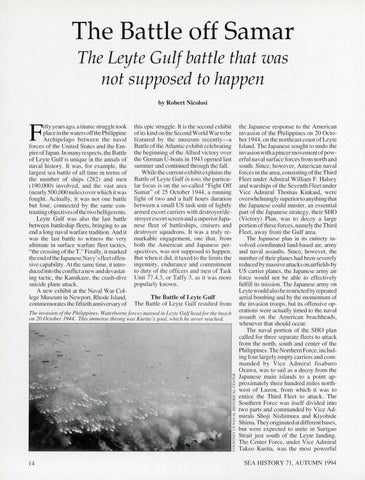The Battle off Samar The Leyte Gulf battle that was not supposed to happen by Robert Nicolosi
ifty years ago, a titanic struggle took place in the watersoffthePhilippine Archipelago between the naval forces of the United States and the EmpireofJapan. In many respects, the Battle of Leyte Gu lf is unique in the annals of naval hi story. It was, for exampl e, the largest sea battl e of all time in terms of the number of ships (282) and men (190,000) involved, and the vast area (nearl y 500,000 miles) over which it was fought. Actuall y, it was not one battle but four, connected by the same contrasting objectives of the two belli gerents. Leyte Gu lf was also the last battle between battleship fl eets, bringing to an end a long naval warfare tradition . And it was the last battle to witness the very ultimate in surface warfare fleet tactics, "the crossi ng of the T." Finall y, it marked the end of the Japanese Navy's fleetoffensive capability. At the same time, it introduced into the conflict a new and devastating tactic, the Kamikaze, the crash-di ve sui cide pl ane attack. A new ex hibit at the Naval War College Museum in Newport, Rhode Island, commemorates the fiftieth anniversary of
F
thi s epic struggle. It is the second exhibit of its kind on the Second World War to be featured by the museum recently-a Battle of the Atlantic ex hibit celebrating the beginning of the Allied victory over the German U-boats in 1943 opened last summer and continued through the fa ll. Whi le the current exhibit ex plains the Battle of Leyte Gu If in to to, the particular focus is on the so-called "Fight Off Sa mar" of 25 October 1944, a running fi ght of two and a half hours durati on between a small US task unit of li ghtl y armed escort carri ers with destroyer/destroyer escort screen and a superior Japanese fl eet of battl eships, crui sers and destroyer squadron s. It was a truly remarka ble engagement, one that, from both the American and Japanese perspecti ves, was not supposed to happen. But when it did, it taxed to the limits the ingenuity, endurance and commitment to duty of the officers and men of Task Un it 77.4.3, or Taffy 3, as it was more popularly known .
The Battle of Leyte Gulf The Battle of Leyte G ulf resu lted from
The invasion of the Philippines. Wat erborn e.forces massed in Leyte Gulf head.for the beach on 20 October 1944. This immense throng was Kurita 's goal, which he never reached.
---
J4
-..,..,
--
the Japanese response to the American invasion of the Philippines on 20 October 1944, on the northeast coast ofLeyte Island. The Japanese sought to undo the invas ion with a pincer movement of powerful nava l surface forces from north and south. Since, however, American naval forces in the area, consisting of the Third Fleet under Admiral William F. Hal sey and warships of the Seventh Fleet under Vice Admiral Thomas Kinkaid , were overwhelmingly supe1ior to anyth ing that the Japanese could muster, an essenti al part of the Japanese strategy, the ir SHO (Vi ctory) Plan , was to decoy a large portion of these forces , namely the Third Fl eet, away from the Gulf area. The Japanese plan in its entirety involved coordinated land-based air, army and naval assaults. Since, however, the number of their planes had been severely reduced by massive attacks on airfields by US carrier planes, the Japanese army air force wo uld not be able to effectively fulfill its mission. The Japanese arm y on Leyte wo uld also be restricted by repeated aerial bombing and by the momentum of the in vasion troops, but its offensive operations were actuall y timed to the naval assau lt on the American beachheads, whenever that shou ld occur. The naval portion of the SHO plan call ed fo r three separate fl eets to attack from the north , south and center of the Philippines. The No rthern Force, including four largely empty carri ers and comma nded by Vice Admira l Ji sa buro Ozawa, was to sail as a decoy from the Japanese main islands to a point approximately three hundred mil es northwest of Luzo n, from which it was to entice the Third Fleet to attack. The Southern Force was itse lf divided into two parts and co mmanded by Vi ce Admirals Shoji Nishimura and Ki yo hide Shima. They ori ginated at different bases, but were expected to unite in Surigao Strait just south of the Leyte landing. The Center Force, under Vice Admiral Takeo Kurita, was the most powerful SEA HISTORY 7 1, AUTUMN 1994
